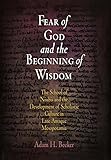Fear of God and the beginning of wisdom : the School of Nisibis and Christian scholastic culture in late antique Mesopotamia / Adam H. Becker.
Material type: TextLanguage: English Series: Divinations: Rereading Late Ancient ReligionPublisher: Philadelphia : University of Pennsylvania Press, [2006]Copyright date: ©2006Description: 1 online resource (315 p.)Content type: text Media type: computer Carrier type: online resourceISBN: 0812201205Subject(s): School of Nisibis | Church history | Iraq -- Church historyGenre/Form: Electronic books.Additional physical formats: No title; No titleDDC classification: 230/.18 LOC classification: BR1105 | .B43 2006
TextLanguage: English Series: Divinations: Rereading Late Ancient ReligionPublisher: Philadelphia : University of Pennsylvania Press, [2006]Copyright date: ©2006Description: 1 online resource (315 p.)Content type: text Media type: computer Carrier type: online resourceISBN: 0812201205Subject(s): School of Nisibis | Church history | Iraq -- Church historyGenre/Form: Electronic books.Additional physical formats: No title; No titleDDC classification: 230/.18 LOC classification: BR1105 | .B43 2006| Item type | Current library | Call number | Status | Date due | Barcode |
|---|---|---|---|---|---|
 Books
Books
|
The BIAA David H. French Library Shelf 43 - Main Room | J8 BECKE 25334 | Not for loan | BOOKS*000000019390 |
Bibliographic Level Mode of Issuance: Monograph
Includes bibliographical references (pages [275]-286) and indexes.
Front matter -- Contents -- Preface -- Note on Transliteration, Spelling, and Terlllinology -- Chronology -- Introduction -- Chapter 1. Divine Pedagogy and the Transmission of the Knowledge of God: The Discursive Background of the School Movement -- Chapter 2. The School of the Persians (Part 1): Rereading the Sources -- Chapter 3. The School of the Persians (Part 2): From Ethnic Circle to Theological School -- Chapter 4. The School of Nisibis -- Chapter 5. The Scholastic Genre: The Cause of the Foundation of the Schools -- Chapter 6. The Reception of Theodore of Mopsuestia in the School of Nisibis -- Chapter 7. Spelling God's Name with the Letters of Creation: The Use of Neoplatonic Aristotle in the Cause -- Chapter 8. A Typology of the East-Syrian Schools -- Chapter 9. The Monastic Context of the East-Syrian School Movement -- Conclusion: Study as Ritual in the Church of the East -- Notes -- Bibliography -- Index -- Acknowledgments
The School of Nisibis was the main intellectual center of the Church of the East in the sixth and early seventh centuries C.E. and an institution of learning unprecedented in antiquity. Fear of God and the Beginning of Wisdom provides a history both of the School and of the scholastic culture of the Church of the East more generally in the late antique and early Islamic periods. Adam H. Becker examines the ideological and intellectual backgrounds of the school movement and reassesses the evidence for the supposed predecessor of the School of Nisibis, the famed School of the Persians of Edessa. Furthermore, he argues that the East-Syrian ("Nestorian") school movement is better understood as an integral and at times contested part of the broader spectrum of East-Syrian monasticism. Becker examines the East-Syrian culture of ritualized learning, which flourished at the same time and in the same place as the famed Babylonian Rabbinic academies. Jews and Christians in Mesopotamia developed similar institutions aimed at inculcating an identity in young males that defined them as beings endowed by their creator with the capacity to study. The East-Syrian schools are the most significant contemporary intellectual institutions immediately comparable to the Rabbinic academies, even as they served as the conduit for the transmission of Greek philosophical texts and ideas to Muslims in the early 'Abbasid period.
English
Description based on print version record.
